Spectrum & Connectivity
The center focuses on developing new solutions that enable communication-intensive applications across large numbers of wireless and mobile devices. These solutions include advanced interference management techniques, better coding and transmission schemes that increase spectral efficiency (bits/s/Hz), scalable protocols for heterogeneous radio networks, and novel protocol and software architectures, particularly cross-layer approaches that work across the traditional network layers. The research targets the licensed cellular networks, technologies operating in the unlicensed bands, emerging frequencies, and dynamic spectrum access.
David Clark
Devavrat Shah
Dina Katabi
Hari Balakrishnan
Jonathan Perry
Keith Winstein
Kermin Elliott Fleming
Peter Iannucci
Swarun Kumar
Yury Polyanskiy
Research topics
Spinal CodesSpinal codes are a new rateless error correcting code designed to efficiently overcome noise and interference plaguing today's wireless networks. Spinal codes are much faster than existing alternative codes, making it possible to provide increased wireless throughput and coverage with existing radio resources. They also work very well over small message sizes, and over highly variable channel conditions, unlike existing alternatives. They are the first rateless code to provably achieve Shannon capacity over both additive Gaussian noise (AWGN) channels and over bit-flip ("BSC") channels with an efficient encoder and decoder. An FPGA hardware implementation of the encoder and decoder achieves over 10 Mbits/s over wireless channels.Investigators: Devavrat Shah Hari Balakrishnan Topics: Spectrum & Connectivity http://nms.csail.mit.edu/spinal
|
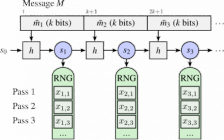 |
SoftCast: A Cross-Layer Design for Scalable Mobile VideoIn broadcast and mobile scenarios the bit rate supported by the channel differs across receivers and varies quickly over time. The conventional design however forces the source to pick a single bit rate and degrades sharply when the channel cannot not support the chosen bit rate. SoftCast is a clean-slate design for wireless video where the source transmits one video stream that each receiver decodes to a video quality commensurate with its specific instantaneous channel quality. To do so, SoftCast ensures the samples of the digital video signal transmitted on the channel are linearly related to the pixels' luminance. Thus, when channel noise perturbs the transmitted signal samples, the perturbation naturally translates into approximation in the original video pixels. Hence, a receiver with a good channel (low noise) obtains a high fidelity video, and a receiver with a bad channel (high noise) obtains a low fidelity video. |
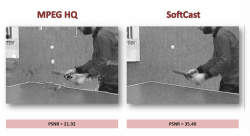 |
Efficient and Reliable Backscatter NetworksThere is a long-standing vision of embedding backscatter nodes like RFIDs into everyday objects to build ultralow power ubiquitous networks. A major problem that has challenged this vision is that backscatter communication is neither reliable nor efficient. Backscatter nodes cannot sense each other, and hence tend to suffer from colliding transmissions. Further, they are ineffective at adapting the bit rate to channel conditions, and thus miss opportunities to increase throughput, or transmit above capacity causing errors. Investigators:
Dina Katabi
Topics:
Low-Power Systems
Mobile Applications
Spectrum & Connectivity
|
 |
TIMO : Making 802.11n Robust to Cross-Technology InterferenceDina KatabiCross-technology interference is emerging as a major problem for 802.11 networks. Independent studies in 2010 by the Farpoint Group, BandSpeed, and Miercom all show that highpower interferers like baby monitors and cordless phones can cause 802.11n networks to experience a complete loss of connectivity. Other studies from Ofcom, Jupiter Research, and Cisco report that such interferers are responsible for more than half of the problems reported in customer networks. |
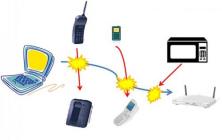 |
802.11n+ : Random Access Heterogeneous MIMO NetworksDina KatabiThis project presents the design and implementation of 802.11n+, a fully distributed random access protocol for MIMO networks. 802.11n+ allows nodes that differ in the number of antennas to contend not just for time, but also for the degrees of freedom provided by multiple antennas. We show that even when the medium is already occupied by some nodes, nodes with more antennas can transmit concurrently without harming the ongoing transmissions. Furthermore, such nodes can contend for the medium in a fully distributed way. |
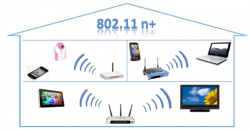 |
MegaMIMO: Scaling Wireless Capacity with User DemandsWe present joint multi-user beamforming (JMB), a system that enables independent access points (APs) to beamform their signals, and communicate with their clients on the same channel as if they were one large MIMO transmitter. The key enabling technology behind JMB is a new low-overhead technique for synchronizing the phase of multiple transmitters in a distributed manner. The design allows a wireless LAN to scale its throughput by continually adding more APs on the same channel. JMB is implemented and tested with both software radio clients and off-the-shelf 802.11n cards, and evaluated in a dense congested deployment resembling a conference room. Results from a 10-AP software-radio testbed show a linear increase in network throughput with a median gain of 8.1 to 9.4. Our results also demonstrate that JMB’s joint multi-user beamforming can provide throughput gains with unmodified 802.11n cards. Investigators:
Dina Katabi
Topics:
Mobile Applications
Spectrum & Connectivity
|
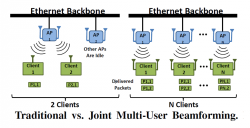 |



